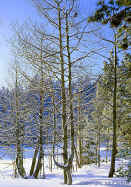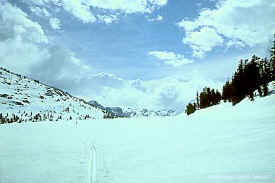Sierra Nature Notes, Volume 1, May 2001
A
White Spring in the Mountains
by Christina Hargis, Ph.D
 When Spring comes to the high country of Yosemite, it comes with a remarkable
display that differs so completely from the well-known fanfare of daffodils
and aromatic lilacs of lower elevations, yet is nevertheless as grand, that
I want to describe it to you. To the unsuspecting observer, Spring sneaks
up quietly, then yells "Surprise!" Herein lies the joy of a High
Sierra spring.
When Spring comes to the high country of Yosemite, it comes with a remarkable
display that differs so completely from the well-known fanfare of daffodils
and aromatic lilacs of lower elevations, yet is nevertheless as grand, that
I want to describe it to you. To the unsuspecting observer, Spring sneaks
up quietly, then yells "Surprise!" Herein lies the joy of a High
Sierra spring.
At first, nothing looks different in the snowy scene that has dominated the winter months in the Sierra. In late March, while a chorus of wildflowers is singing in the Sierra foothills, the trunks of lodgepole pines and red firs at higher elevations are still buried in several feet of snow and the night temperatures are in the low teens. But a cross-country ski trip reveals changes in the quality of the snow from the previous months. On north-facing slopes, the interlocking snow crystals unclasp each other as the warming days round their pointy ends and turning last month’s powder into grainy little balls that skiers call "corn snow". It feels like you are skiing down a slope of granulated sugar as the skis slice through the rounded crystals.
But corn snow
can be found even in January if the weather has been warm and dry for a spell,
so this is not always a sign of spring. The signal event is found in the still
snow-laden meadows. If you visit one on a March afternoon and face toward
the sun, you will find that the snow is no longer white but a breathtaking
silver - shimmering like mercury. Gone are the crystalline shapes of January
and February. The meadow has slipped into a slinky silk dressing gown, and
it seems at any moment she will let it slither to her feet.
The Sounds of Spring
In the high country, spring is often heard before it is seen. The first tones
are the †questioning
calls † of great-horned
owls who begin their mating sounds earlier than most birds, whether at high
or low elevations. Like the appearance of groundhogs, the hoots of great-horned
owls in February remind us that spring is not here yet, but will be arriving
soon.
It isn’t until April that the undeniable sounds of spring fill the high country forests, but they are not the warbles and trills of songbirds that you might suppose. At 8,000 feet, among the lodgepoles, the sound of spring is:
D-r-r-r-r-r…..dunk-dunk-dunk-dunk-dunk.
D-r-r-r-r-r…..dunk-dunk-dunk-dunk-dunk
It comes from the dead tree across the meadow, and from another dead tree on the little ridge, and the one down by the creek that is beginning to gurgle under the snow. From all around you the loud, drumming rhythm is repeated again and again. If you ski across the meadow to investigate, you’ll see a winged daffodil – the Williamson’s Sapsucker – flashing a brilliant yellow belly as it flies from one dead tree to the next to continue drumming the sound of spring.
This colorful woodpecker seems to disappear from the higher elevations during the winter, but returns in large numbers to stake out breeding territories and attract mates with the loud distinctive drumming. In many lodgepole pine forests, the drumming of Williamson’s Sapsuckers is the dominant sound in April and early May – as surely as the flowers that bloom in the lower country, an unquestionable sign of spring..
Like the lodgepole pine forest, the red fir community is quiet for most of the winter, except for the daily chatter of Stellar Jays, Mountain Chickadees, and nuthatches, both red and white breasted. Within this forest type, spring is heralded by a †deep-pitched tone thumping softly† from the higher branches of a fir. The sound is so soft and low that the swishing glide of cross-country skis can mask it, but if you stop to shed a sweater on a warming April day, it is hard not to miss the deep thrums that fill the air.
Sometimes it is hard to find the musician, not only because he’s a bit of a ventriloquist, but he blends so well with the tree branches. But patience and a keen eye will eventually spot a male Blue Grouse perched on a high limb, often nestled against the trunk. It is hard to believe that such deep tones are emanating from this forest chicken, but close observation will expose the trick. The grouse extends his head forward and lifts his neck feathers, revealing a red-and-white laced air sac. His neck pulses as he forces air into this miniature drum, and the sounds seem to come from the tree behind you rather than from this soft gray bird. While he drums, his tail feathers spread out, a band of silver-gray highlighting the tips. The Blue Grouse is not as showy as his relatives, the Sage Grouse and Prairie Chicken, and he does not always elevate his tail feathers when he drums. But nevertheless, the inflated red airsac and outspread tailfeathers are a sight to behold, both to female grouse and awestruck skier alike. After a few pulses, the bird relaxes and returns to his original stance, crouched low on the limb. The Blue Grouse is not as ubiquitous as the Williamson’s Sapsucker, but sometimes you can hear more than one male drumming through the firs.
This is not to say that spring in the high country is completely without the warbling trills of songbirds, for the Cassin’s Finch returns fairly early and sings loud and long from tree tops. The intricate warbling goes on and on, and you wonder when the singer has time to catch his breath. If the sapsucker is the high country’s daffodil, then the Cassin’s Finch is its tulip, with brilliant red head and red-streaked breast. Those of you who know the house finch will find a strong similarity in this close relative.
Perhaps the mountain
chickadee gains inspiration from the Cassin’s Finch, for this little
black and white ball of feathers begins to increase its repertoire with the
arrival of sapsucker and finch. The chickadee’s breeding song consists
of three clear notes that sing out "Sweet Ba-by". At other times
it murmurs a soft warble, as intricate as the Cassin’s Finch but never
as loud.
Skiing Into Spring
Sapsucker, finch, chickadee. Storms will temporarily douse the enthusiastic
chorus, but never quench it entirely. And likewise, snow may still lie deep,
but it can no longer hide the rich aroma of thawing soil, a scent that is
as fragrant as lilacs if you have smelled only snow for months. Even the trees
emit a pleasant scent as sap begins to flow and bark is warmed by the sun.
The snow yields its grip on the trunks, creating deep "tree wells"
and sometimes even bare earth. Every day another bowed-over sapling springs
upright again, freed at last from the weight that has pinned its top down
all these months.
 Occasionally
one gets an unusual glimpse of spring, beyond the common signs I have just
described. I enjoyed one such occasion after skiing across an 11,000 foot
pass in Yosemite to spend a solitary lunch at the edge of a frozen mountain
lake. It was April 27, and I reached for more sunscreen, remembering that
I’ve gotten my worst burns in spring when the brilliant sun reflects
off the snow. With head peering into pack, I felt and heard a zip of small
wings just inches away, but by the time I glanced up, the swift traveler was
gone. In less than a minute, another zip caught my attention, and this time
I saw that it was a Violet-green Swallow with iridescent green wings and white
patches at the base of its tail.
Occasionally
one gets an unusual glimpse of spring, beyond the common signs I have just
described. I enjoyed one such occasion after skiing across an 11,000 foot
pass in Yosemite to spend a solitary lunch at the edge of a frozen mountain
lake. It was April 27, and I reached for more sunscreen, remembering that
I’ve gotten my worst burns in spring when the brilliant sun reflects
off the snow. With head peering into pack, I felt and heard a zip of small
wings just inches away, but by the time I glanced up, the swift traveler was
gone. In less than a minute, another zip caught my attention, and this time
I saw that it was a Violet-green Swallow with iridescent green wings and white
patches at the base of its tail.
I patted my pack into a comfortable seat on the snow, and began to nibble crackers and cheese. Two more swallows flew by, coming from the pass behind me, heading northwest. Off to the left were ten more swallows, all flying in the same direction. In a short time I saw three more to my right, four more straight overhead. The crackers and cheese were followed by dried fruit, and another fifty swallows sailed across the pass, in groups of two to ten. And finally came the chocolate bar, savored slowly, while more swallows swished across the pass and some even swooped near my head. I was sitting in the middle of a major migration corridor, and within an hour over two hundred swallows had winged their way past my lunch spot. I had only come to enjoy the scenery of rocks and icy lake, but was treated to a special springtime event. Over the next two weeks, I saw many flocks of swallows flying across the meadows, forests, and peaks around Tuolumne Meadows, always disappearing to the north and northwest. It wasn’t until mid-May that some individuals chose to stay.
And so this tale takes us to mid-May: by the time the swallows stop to perch, spring has at last gotten the upper hand over winter. Patches of bare earth grow larger and snow holds its grip only on the north facing slopes. The forest is now hospitable for robins, Yellow-rumped Warblers, and juncos. Mountain Bluebirds bring a new color to the subalpine meadows, a delicate blue that appears even more brilliant against the patches of white snow and clumps of dried yellow grasses.
Then one day in late May, you might find a bear track stomped into one last patch of soggy snow, and a Yellow-bellied Marmot sunning on a rock in the middle of old avalanche debris. These mammals probably emerged a few weeks ago, and they need new green shoots to fill their empty bellies. White spring ends with white avalanche lilies and the greening of the high Sierra.
Great
Horned Owls calling from Christine Tarsky, About.com
bird guide. Recording copyright by Doug Von Gausig and Naturesongs.com,
1997, '98, '99, and 2000.
Blue Grouse call from the Grace
Bell Collection at the Royal BC Museum.
Dr.Christina Hargis is Assistant Leader of the USDA Forest Service Terrestrial Wildlife Ecology Unit. Formerly she worked in Yosemite National Park and experienced several winters and white springs in the high country of Tuolumne Meadows as a backcountry ranger with Mead Hargis.
Our Founder Questions? Go to About Our New Site |
Masthead
Photo from: |